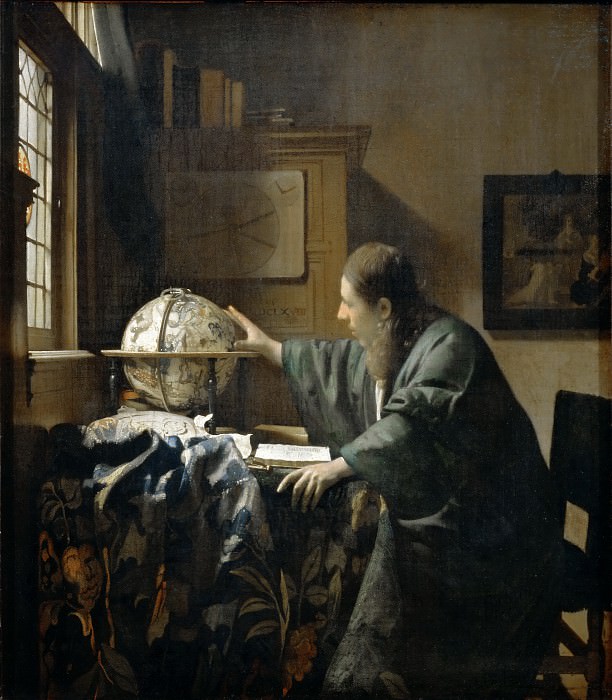The Astronomer Johannes Vermeer (1632-1675)
Johannes Vermeer – The Astronomer
Edit attribution
Image taken from other album: gallerix.org/s/3575090783/N/3641400665/
Download full size: 3511×4018 px (4,8 Mb)
Painter: Johannes Vermeer
Location: Louvre (Musée du Louvre), Paris.
In the golden age of freedom and prosperity of Protestant Holland, the enigmatic painter Vermeer was born. Not only did he create, but he was also engaged in commerce. Little is known about Jan Vermeer’s career, but he was always surrounded by art. The artist was influenced by Italian painting and the work of Caravaggio. The strong colors and dense coat of paint indicate Italian influence. The modern genre subject became a leading leitmotif and feature of his work. The mature painter chose a certain canvas format of 45x41 centimeters for all his works.
Description of the painting "Astronomer" by Jan Vermeer
In the golden age of freedom and prosperity of Protestant Holland, the enigmatic painter Vermeer was born. Not only did he create, but he was also engaged in commerce.
Little is known about Jan Vermeer’s career, but he was always surrounded by art. The artist was influenced by Italian painting and the work of Caravaggio. The strong colors and dense coat of paint indicate Italian influence. The modern genre subject became a leading leitmotif and feature of his work.
The mature painter chose a certain canvas format of 45x41 centimeters for all his works. The painter’s unique gift also lies in the way he deals with light, and his strength is in transforming a simple image into a monumental one, as well as in his attention to the details of everyday life.
He conveys objects with meticulous precision to the textures and characters of people. Vermeer was a brilliant master of light and shade, achieving subtle lighting effects through skillful layering of paint. Researchers of Vermeer’s art believe that he used ancient optics - the camera obscura.
In Vermeer’s paintings, geographical maps like the globe in Astronome symbolize the power of Holland, which the artist glorifies, because in the 17th century it was a prosperous and rich country, thanks to international trade.
The astronomer’s profession and the title of the painting is an image in an age of reason and science, and man is the master of the planet. The subtly lit scene accurately shows the relationship between humanity and the planet, and knowledge is key in that relationship. It is reflected in the texts on the table. The man sitting at the table is Antony Van Leeuwenhoek, the developer of the microscope.
It is known that the artist and the scientist were acquainted, and the latter was dealing with the tangled financial affairs of the creator in Delft.
Кому понравилось
Пожалуйста, подождите
На эту операцию может потребоваться несколько секунд.
Информация появится в новом окне,
если открытие новых окон не запрещено в настройках вашего браузера.
You need to login
Для работы с коллекциями – пожалуйста, войдите в аккаунт (open in new window).














![Johannes Vermeer - Girl with the Red Hat [attr.]](http://cdn.gallerix.asia/j/V/306549019/876244957.webp)





You cannot comment Why?
The painting The Astronomer by Johannes Vermeer depicts a man intently focused on a celestial globe. He is shown in profile, wearing a simple robe, with his right hand resting on the globe and his gaze directed towards it. Light streams in from a window on the left, illuminating the room and casting a soft glow on the astronomers face and the objects on his desk.
Detailed elements visible include:
Subtexts and Interpretations:
The Astronomer is rich with layers of meaning, common in Vermeers works: